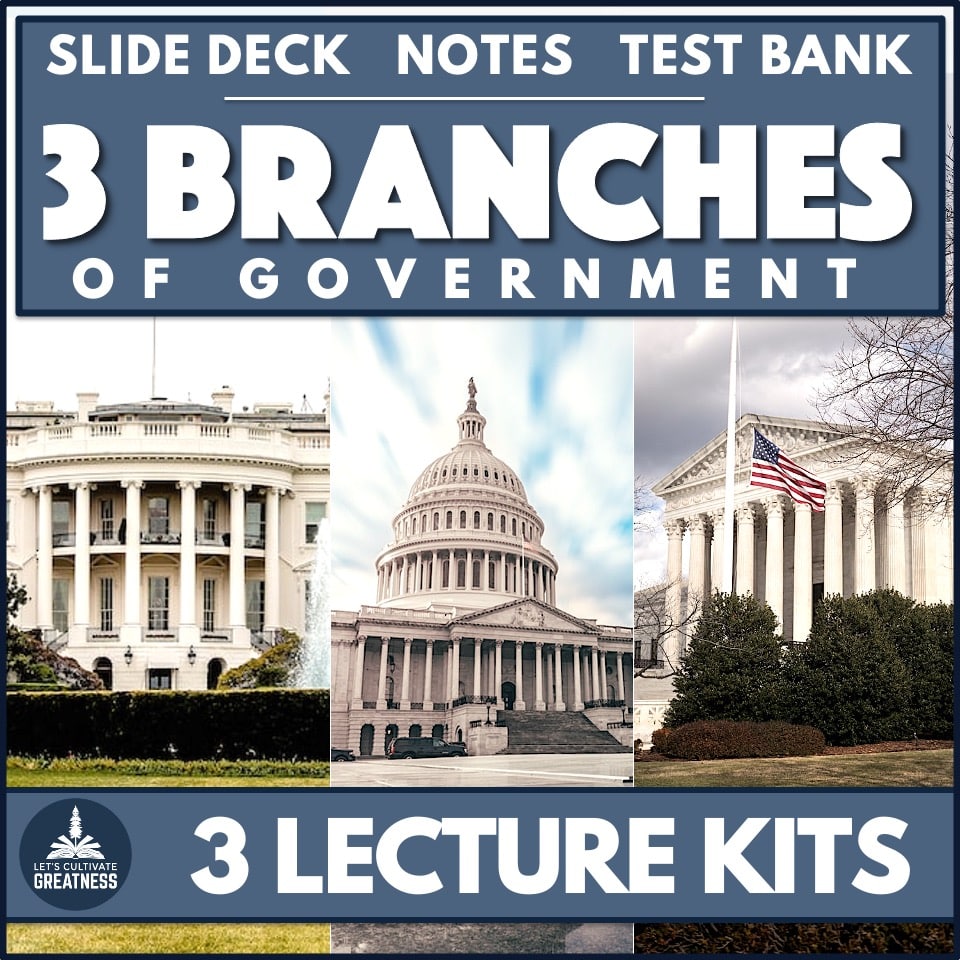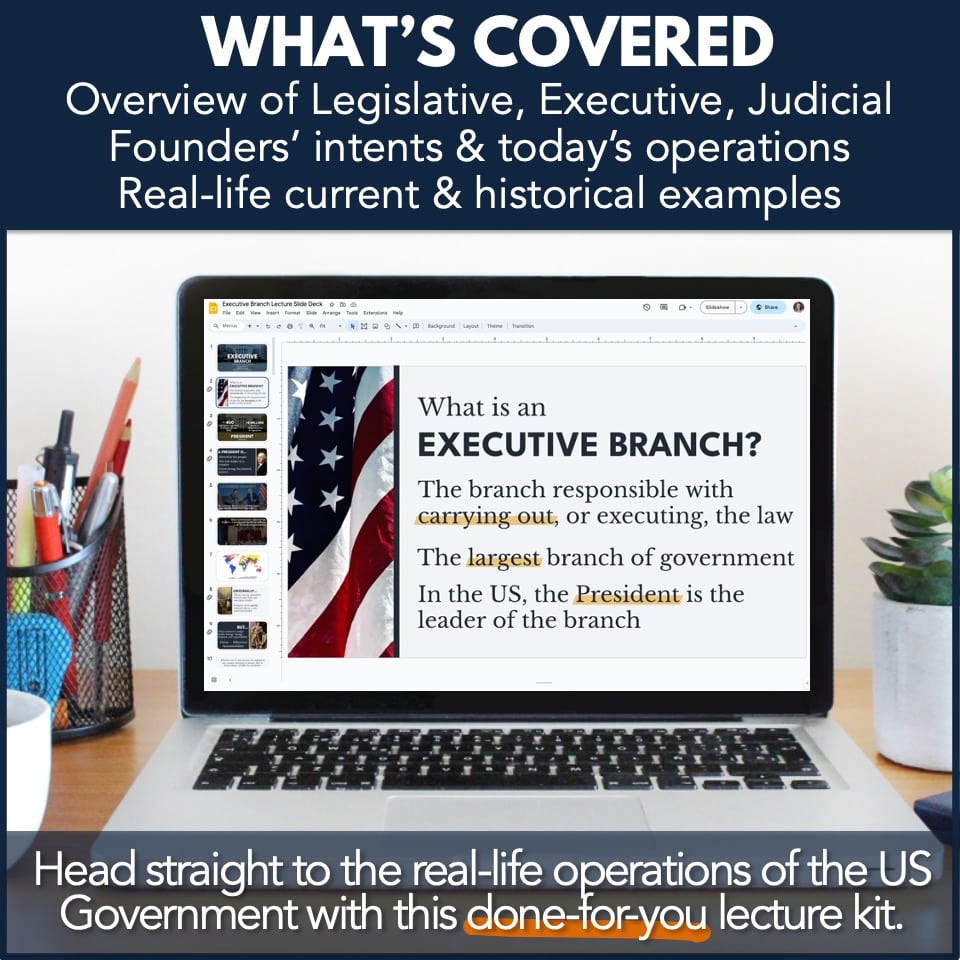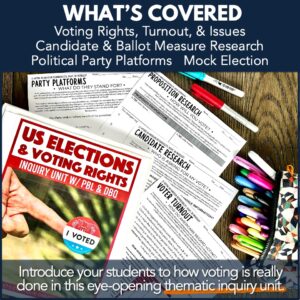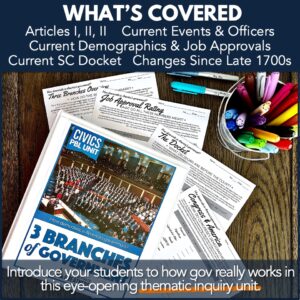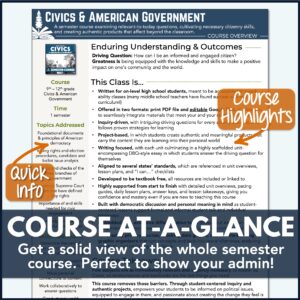Three Branches Lecture Kit Bundle
$14.50
Confidently teach all three branches with this complete lecture kit bundle!
Each branch’s lecture kit comes with ready-to-go guided notes, a 50-question test bank, and slide-by-slide teacher scripts.
Description
When new concepts are presented in bite-sized chunks, with visuals and immediate real-life examples, it sticks. This lets you spend more time doing the projects and activities that students enjoy!
Use this bundle to guide your Legislative, Executive, and Judicial branch units.
Each of these three branches lecture kit includes:
70-95-Slide Lectures
- Clean, modern look in Google Slides
- Extensive teacher scripts on every slide
- Embedded animations to focus attention
- “Pause and Talk” reflection & processing questions at the end of each segment
2 Differentiated Versions of Accompanying Notes
- 4-Page Guided Notes for on-level students
- 4-Page More Scaffolded Fill-in-the-Blank Notes for support students
- Print PDF and Google Doc files of both sets
- Answer Key
50-Question Test Bank
- Easily copy/paste questions to build quizzes and formative checks natively into your LMS or other platform
- Fill-in-the-blank, matching, short-answer, and open-ended questions included
- Answer key included too!
Legislative Branch Lecture Kit covers:
- Terminology: legislature, legislator, legislative
- Comparison to other nations & parliament system
- The bicameral system
- Founder’s intentions with an “upper” & “lower” house
- 17th Amendment
- Senator requirements & specific powers
- House of Representative requirements & specific powers
- Political party makeup of current Congress
- Senate Leadership & Current Members:
– President and President Pro Tempore
– Majority & Minority Leaders
– Your state’s Senators - Current House Leadership & Current Members:
– Speaker of the House
– Majority & Minority Leaders
– Your Congressional District’s Representative - Expressed or enumerated powers
– Pass a budget, spend money, collect taxes, trade
– Maintain military, declare war
– Maintain post offices, roads, citizenship, patents & copyrights
– Maintain federal lands
– Necessary & Proper Clause - How a bill becomes a law
– Submission
– In Committee
– Floor Debate; filibuster
– President sign, veto
Executive Branch Lecture Kit covers:
- Founders’ intentions with creating a single President
- Job qualifications & the debate over “natural-born” requirement
- 22nd Amendment & term limits
- Comparison with other countries’ leader set-ups
- Official roles:
– Head of Government — appointments, budget, State of the Union
– Chief Diplomat — treaties, UN & G7 meetings, Logan Act
– Commander in Chief — undeclared wars & the Wars Power Act, military attacks, the nuclear football - Unofficial roles:
– Head of State — State diner, Presidential Medal of Freedom, Easter Egg Roll
– Head of Party — campaigning for other candidates
– World Leader — UN Security Council member, world treaties, international policies - Expressed Presidential powers:
– Signing/vetoing bills
– Granting pardons
– Appointing federal judges - Implied Presidential powers:
– Executive orders
– Executive agreements
– Executive privilege - Role & Duties of the Vice President
- Role and members of the Cabinet
- 25 executive departments and agencies
Judicial Branch Lecture Kit covers:
- Founders’ intentions with creating an isolated judiciary
- Lifetime appointments, “in good behavior” standing
- Unofficial requirements expected of a federal judge
- Comparison with other countries’ requirements for judges
- Judiciary Act of 1789
- District & Circuit courts
- Presidential appointment with Senate confirmation
- Marbury v. Madison & judicial review
- Textualist, Orginialist, & Living Constitutionalist interpretations
- Judicial restraint & judicial activism
- Supreme Court ruling “tests” to set precedents
- Majority & Minority Opinions
- Original & Appellate jurisdiction
- Overturning Supreme Court rulings, constitutional amendments
- Current members & leaning of the Supreme Court
- Landmark cases highlighted to illustrate concepts listed
– Dred Scott v. Sanford
– Riley v. California
– Dobbs v. Jackson
– Obergefell v. Hodges
– Virginia v. Tennessee
– Brandenburg v. Ohio
– Schenk v. United States
– Brown v. Board
– Plessy v. Ferguson
– Texas v. Johnson
This resource is over 240 total slides, plus 15 total PDF pages.
What grades is this intended for?
This was designed for high school.
What supports are included? How can I modify this?
Each guided notes sheet chunks episodes into manageable segments and skill sheet handouts are provided for the accompanying political cartoons and news articles analysis extension activities.
Can I use this in a homeschooling setting?
Sure! Everything in this kit can easily be used in a solo or a small-group setting.
Is this editable? What file types does this resource come in?
The main resource comes as a secured, non-editable PDF file intended to be printed.
Included are links to editable Google Doc files of student materials, to customize to your classroom needs and assign digitally if you choose. The skill sheet handouts are not editable.
What standards does this address?
Several! Standards vary, but this resource supports these from various states:
- Analyze the structure and functions of the legislative branch of government, including the bicameral structure of Congress, the role of committees, and the procedures for enacting laws
- Identify the methods for determining the number of members in the House and Senate
- Describe the enumerated and implied powers delegated to Congress
- Analyze the role of Congress in terms of its relationship with other branchesAnalyze the structure and functions of the executive branch of government, including presidential powers and the role of the Cabinet and executive departments
- Examine the relationship the executive branch has with the other branches, including checks it has on the other branches
- Describe the official and unofficial roles of the office of the President; explain the qualifications needed for the job
- Describe the enumerated and implied powers of the office of the President
- Explain the role of the Cabinet and executive departments in advising the President and carrying out their orders
- Analyze the structure and functions of the judicial branch, including the federal court system and types of jurisdictions
- Examine the judicial branch’s relationship with the other branches; describe the role of the Supreme Court and the lesser federal courts
- Explain what Article III says about judicial tenure, appointments, salaries, & jurisdictions
- Describe the purpose and function of judicial review; explain the relationship between judicial review and the Supremacy Clause
- Compare the ways state and federal judges are appointed compared to elected officials
- Recognize the role of the Federal Judiciary Act of 1789 in establishing the federal courts system;
- describe the relationship between the Supreme Court and district and appellate courts
- Explain the decision-making process in interpreting law; explain the difference between judicial review and restraint
- Describe various landmark Supreme Court cases, relating them to the Constitution and Bill of Rights
What are the terms of use for this resource?
This resource, including all ancillary files, may be used as needed for regular, non-commercial single-classroom use between a teacher and their students.
This includes printing copies and sharing digital files with students through a secure platform, like Google Classroom or Canvas, email, or a classroom-only shared drive.
The using and sharing of any part of this resource in any manner outside the above-mentioned capacity is strictly prohibited. Prohibited uses include, but are not limited to,
- posting files on the open internet or in a Facebook group
- emailing files to or sharing print copies with others (without purchasing additional licenses)
- uploading or storing files in a shared cloud drive accessible by anyone other than students
- including any part, or any derivative work, within any commercial endeavor like curriculum development, professional training, or for-profit teaching like Outschool, or selling this resource as your own in either print or digital formats
Doing so violates the Digital Millennium Copyright Act (DMCA), copyright law, and these terms.
By downloading this resource from Let’s Cultivate Greatness, the original user has been granted one license for a single teacher (or number of teachers matching the number of licenses purchased) and their students at any one time.
Let’s Cultivate Greatness retains the full copyright of this resource.

